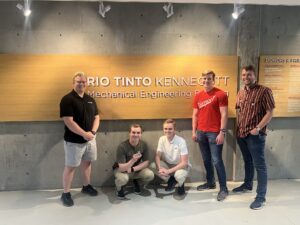Each year, the largest scholarly societies for mechanical and electrical engineers, ASME and IEEE, host their Student Heat Sink Design Challenge. Heat sinks serve a simple but critical role in computers and many other electronics: absorb and dissipate the heat generated by those devices before they damage themselves. The design competition sees students explore the possibilities and advantages of additive manufacturing, in this case, 3D printed aluminum, to maximize the performance of a particular type of heat sink.
 A team of students from the Department of Mechanical Engineering took home the top prize in this year’s competition, which focused on a natural convection heat sink in a vertical enclosure.
A team of students from the Department of Mechanical Engineering took home the top prize in this year’s competition, which focused on a natural convection heat sink in a vertical enclosure.
The winning team consisted of Preston Bodily, Taylor Cox, Chandler Elliott, Zach Julien, and Xander Lehnardt. They were co-advised by Dr. Samira Shiri, Dr. Tilani Feng, and Dr. Sameer Rao. Their preliminary process consisted of brainstorming, simple testing, and iterating on designs using a SOLIDWORKS simulation to predict the Figure Of Merit (FOM). After trying multiple designs, the team settled on the X Tent, which optimized disruption of the convective boundary layer and supply of cold ambient air.
From there, the team focused on reducing mass and decreasing the temperature. The group shifted to a more rigorous testing method using ANSYS Fluent to better estimate and confirm the prediction of FOM. This included defining a mesh based on their 3D model and environment, setting up materials and boundary conditions, and gathering the final data. With this information, the team found unnecessary mass to remove and extended surfaces to improve natural convection.
Read more at the Department of Mechanical Engineering.